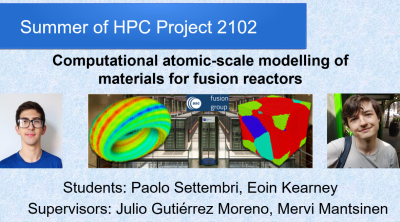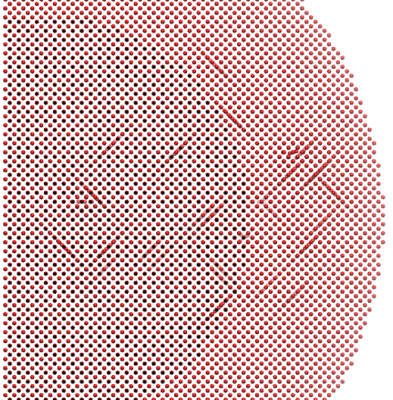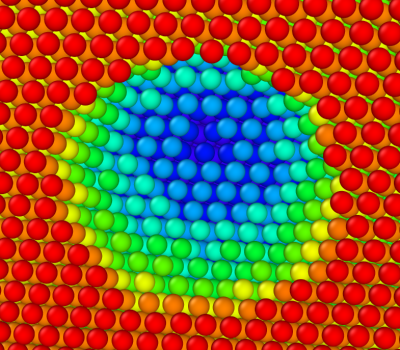
Hello! As part of the Summer of HPC project ‘Computational atomic-scale modelling of materials for fusion reactors‘ organised by PRACE (Partnership for Advanced Computing in Europe) we, Eoin Kearney (from the Erastova group, University of Edinburgh) and Paolo Settembri (University of L’Aquila), joined the fusion group of the Barcelona Supercomputer Center (BSC) in the months of July and August. It was a great opportunity, and we’d like to share our experiences of the summer and working with the group.
We were supervised by Julio Gutiérrez Moreno and the group leader Mervi Mantsinen. They were a great help and really supportive throughout our project. As the project was online due to the pandemic it would have been easy to become disconnected, but they helped us feel welcome in the group. Being part of group meetings also helped us feel part of everything.
Now below we’ll give you an introduction to our projects and how the summer went.
Why it is important to study materials for fusion reactors?
To sustain the incredibly harsh conditions inside a nuclear fusion reactor, high performance materials must be used. One of the key materials for nuclear fusion reactor components is Tungsten, which has been at the center of our project, due to its high melting point (the highest in all metals) and its good thermal conductivity.
This makes it perfect for the harsh thermal conditions, but it faces a critical problem; the damage caused by the particles present in the reactor. These include the input to the reactor, the two Hydrogen isotopes deuterium and tritium, and the output of fusion, Helium atoms and neutrons.
The damage due to neutron collisions at an atomic level is serious because of their high energy, given the temperature of the reactor core. For example, neutrons can initiate chain events from an initial collision with a Tungsten atom, called defect cascades, that will result in the displacement of several atoms from the lattice structure and the formation of vacancies.
These changes in the structure will then affect the properties of the material, and such variations need to be studied computationally to have a clear picture of what will happen in future, prolonged nuclear fusion experiments. To study the defect cascades and the effect of vacancies on the thermal conductivity of Tungsten we used molecular dynamic simulations, performed using the LAMMPS code.
Eoin’s project: Studying Defect Cascades
For my end of things as a chemist, compared to Paolo and his Physics, I focused on the interactions of atoms and producing the defect cascades previously mentioned. A single Tungsten atom in a block was given a high energy (up to 200 keV), and the resulting cascade was observed and analyzed. The initial programming of the simulation took some trial and error expanding a script Julio prepared. Once it was running, analysis showed defect cascades were similar to previous studies in the literature in terms of the final number of defects formed at different cascade energies, showing that we had established a successful cascade procedure. Going further in the project would then involve connecting it up to Paolo’s work below, which we unfortunately couldn’t achieve due to the limited time frame, and looking into cascades in Tungsten alloys. Overall LAMMPS was a joy to work with, and the coding and searching for results was very rewarding.

Paolo’s project: Studying Thermal Conductivity
This part of the project was focused on calculating the thermal conductivity of Tungsten, and investigating how the presence of empty bubbles inside a perfect Tungsten crystal changes this property. With the great help of Julio, a LAMMPS script has been written to perform different simulations, the results of which were then analyzed and an estimate of the systems thermal conductivity values were obtained.
This has been repeated using different interatomic potentials and system sizes, and the obtained results, that depend on the potential used, were found to be compatible with previous papers. We then introduced an empty bubble inside the crystal and studied the thermal conductivity variation while increasing the size of the bubble. We found a decreasing linear behaviour for thermal conductivity with increasing sphere surface, as expected. This work can be the basis for future interesting research, for example injecting Hydrogen and Helium atoms inside the bubbles, as would happen in a nuclear fusion reactor.

Conclusion
We approached the project from different ends, Paolo working on the calculations of thermal conductivity while Eoin produced defect structures. Still, we were able to support each other quite well when issues arose and the cooperation made the presentations and video we produced very enjoyable. A side of things we both enjoyed was getting to grips with the literature on fusion, especially learning about the state of the art and the position of various large scales plants in their long-running timetables. The overlap of these massive engineering projects with our atomic-scale theoretical chemistry is a fascinating area to study. The two months went by very quickly but having interesting work to investigate on a well planned project made it a very productive time.
We want to thank everyone that made this experience possible and supported us during its course, especially Julio, Mervi and the fusion group.
This was a great way to spend the summer!
More information about our projects and others can be found at the Summer of HPC website: Summer of HPC Website, Eoin’s blog posts, Paolo’s blog posts

-Thank you for this very useful information. I learned a lot in this webpage. Thank you very much.
Can you share some of the key responsibilities of the two students during their internship in the Fusion group?